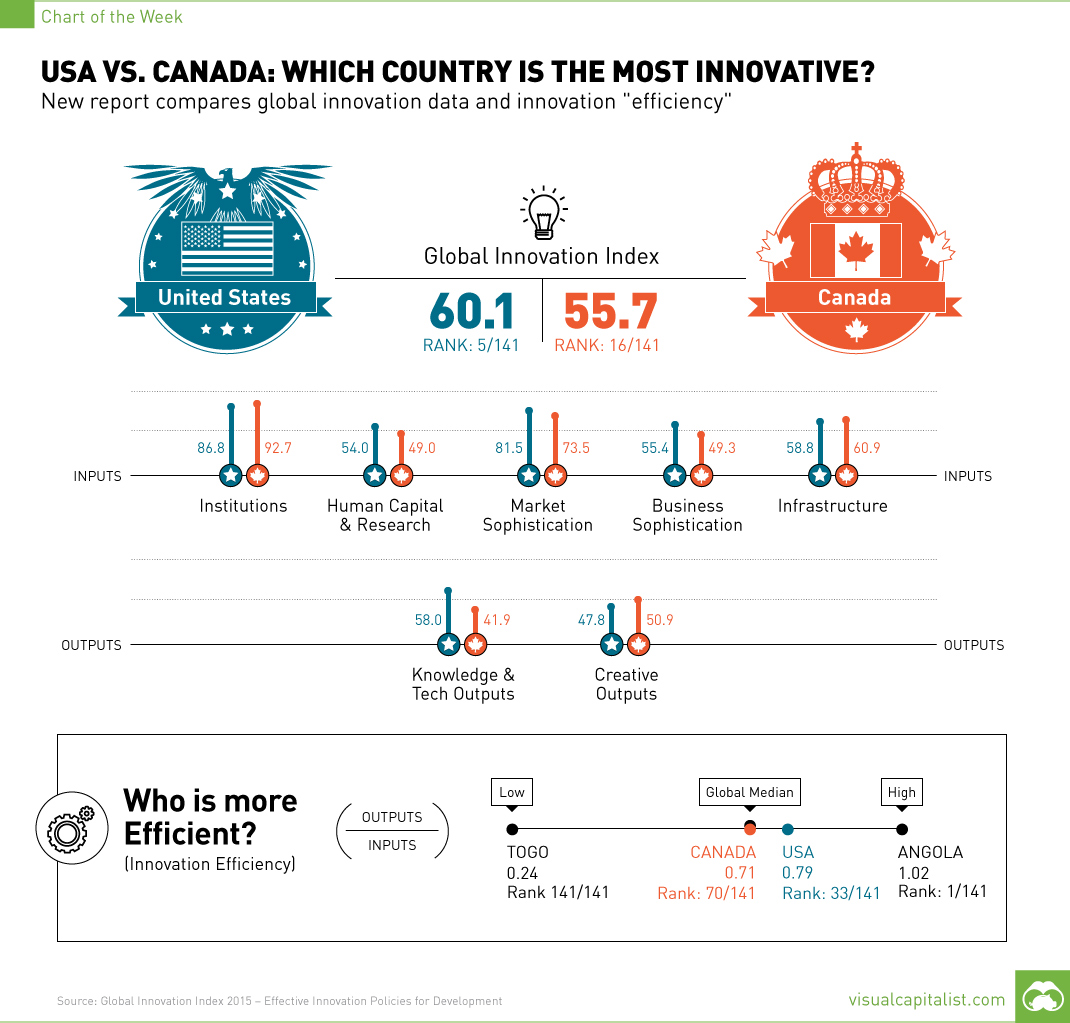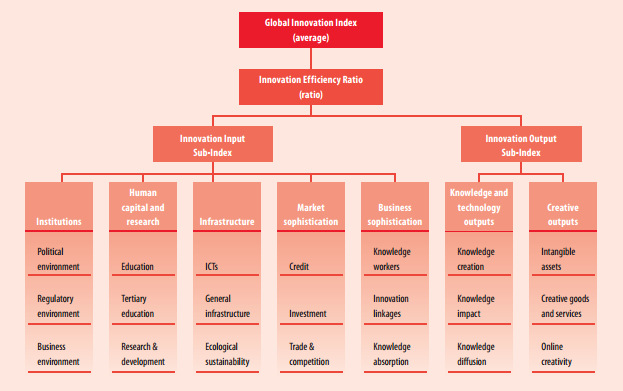USA vs. Canada: Which is the Most Innovative Country? [Chart]
The Chart of the Week is a weekly Visual Capitalist feature on Fridays. This week, an in-depth report on global innovation was co-released by Cornell University, INSEAD, and the World Intellectual Property Organization. The 2015 version of the report is not for the faint of heart: it clocks in at 453 pages long and covers a total of 141 countries that make up 98.6% of global GDP. The methodology of the report uses innovation inputs and outputs to create an overall Global Innovation Index with a score for each country. Inputs include factors such as institutions, human capital, infrastructure, market sophistication, and business sophistication. Outputs deal with actual innovation results such as knowledge, technology, and creative outputs. Lastly, there is also a curious measure which divides outputs by inputs to find an “efficiency” factor: in other words, which countries are getting the most bang for their buck in terms of innovation. Global Innovation Index Framework: The data is quite granular, and each innovation score is based on 79 variables. Rather than comparing all countries together, we decided to look at Canada and the United States to see which of the 49th parallel neighbors is the most innovative country. If you’d prefer to read an executive summary of the report itself, there is an abstract here that includes more analysis on other countries such as Switzerland and the United Kingdom, which came in first and second place respectively in the overall rankings.
USA vs. Canada
Many of the wealthy countries in the report, including Canada and the United States, have a quality set of inputs for innovation: world-class universities, fair regulatory environments, sophisticated economies, and strong knowledge workers. However, the report shows a few big differences specifically between Canada and the United States that are worth noting. Firstly, the “quality of innovation” in the United States is higher. University performance, the reach of scholarly articles, the international dimension of patent applications, and other such measures have the USA as the top place within the entire high-income group, followed by countries such as the UK, Japan, Germany, and Switzerland. This helps the United States get a better score than Canada in terms of Knowledge and Technology Outputs, which make up half of the formula for the overall index. The United States scores a 58.0 on those outputs, while Canada scores 41.9. Next, the United States holds the top position globally in measures concerning Market Sophistication, which gives it a score of 81.5 compared to Canada’s 73.5 in that category. Canada almost makes up for this with its strong institutions. In terms of Business Environment (a sub-category to “Institutions”) Canada has the best ranking in the world. However, the United States has strong institutions as well, and the difference here is only 5.9 points. Lastly, Canada’s score was impacted by its weakness in the Human Capital and Research category, where it dropped from 13th to 22nd in ranking since the previous year’s report. This weakness is described by the authors as being linked to “government spending on secondary education per pupil, where [Canada] ranks 65th”.
on But fast forward to the end of last week, and SVB was shuttered by regulators after a panic-induced bank run. So, how exactly did this happen? We dig in below.
Road to a Bank Run
SVB and its customers generally thrived during the low interest rate era, but as rates rose, SVB found itself more exposed to risk than a typical bank. Even so, at the end of 2022, the bank’s balance sheet showed no cause for alarm.
As well, the bank was viewed positively in a number of places. Most Wall Street analyst ratings were overwhelmingly positive on the bank’s stock, and Forbes had just added the bank to its Financial All-Stars list. Outward signs of trouble emerged on Wednesday, March 8th, when SVB surprised investors with news that the bank needed to raise more than $2 billion to shore up its balance sheet. The reaction from prominent venture capitalists was not positive, with Coatue Management, Union Square Ventures, and Peter Thiel’s Founders Fund moving to limit exposure to the 40-year-old bank. The influence of these firms is believed to have added fuel to the fire, and a bank run ensued. Also influencing decision making was the fact that SVB had the highest percentage of uninsured domestic deposits of all big banks. These totaled nearly $152 billion, or about 97% of all deposits. By the end of the day, customers had tried to withdraw $42 billion in deposits.
What Triggered the SVB Collapse?
While the collapse of SVB took place over the course of 44 hours, its roots trace back to the early pandemic years. In 2021, U.S. venture capital-backed companies raised a record $330 billion—double the amount seen in 2020. At the time, interest rates were at rock-bottom levels to help buoy the economy. Matt Levine sums up the situation well: “When interest rates are low everywhere, a dollar in 20 years is about as good as a dollar today, so a startup whose business model is “we will lose money for a decade building artificial intelligence, and then rake in lots of money in the far future” sounds pretty good. When interest rates are higher, a dollar today is better than a dollar tomorrow, so investors want cash flows. When interest rates were low for a long time, and suddenly become high, all the money that was rushing to your customers is suddenly cut off.” Source: Pitchbook Why is this important? During this time, SVB received billions of dollars from these venture-backed clients. In one year alone, their deposits increased 100%. They took these funds and invested them in longer-term bonds. As a result, this created a dangerous trap as the company expected rates would remain low. During this time, SVB invested in bonds at the top of the market. As interest rates rose higher and bond prices declined, SVB started taking major losses on their long-term bond holdings.
Losses Fueling a Liquidity Crunch
When SVB reported its fourth quarter results in early 2023, Moody’s Investor Service, a credit rating agency took notice. In early March, it said that SVB was at high risk for a downgrade due to its significant unrealized losses. In response, SVB looked to sell $2 billion of its investments at a loss to help boost liquidity for its struggling balance sheet. Soon, more hedge funds and venture investors realized SVB could be on thin ice. Depositors withdrew funds in droves, spurring a liquidity squeeze and prompting California regulators and the FDIC to step in and shut down the bank.
What Happens Now?
While much of SVB’s activity was focused on the tech sector, the bank’s shocking collapse has rattled a financial sector that is already on edge.
The four biggest U.S. banks lost a combined $52 billion the day before the SVB collapse. On Friday, other banking stocks saw double-digit drops, including Signature Bank (-23%), First Republic (-15%), and Silvergate Capital (-11%).
Source: Morningstar Direct. *Represents March 9 data, trading halted on March 10.
When the dust settles, it’s hard to predict the ripple effects that will emerge from this dramatic event. For investors, the Secretary of the Treasury Janet Yellen announced confidence in the banking system remaining resilient, noting that regulators have the proper tools in response to the issue.
But others have seen trouble brewing as far back as 2020 (or earlier) when commercial banking assets were skyrocketing and banks were buying bonds when rates were low.















